The first event on 3D printing in the Netherlands
3d printing event
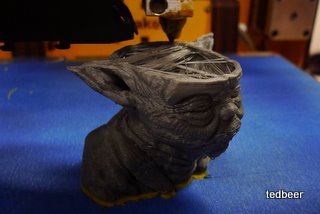
Not so long ago became interested in 3D printing. And then I stumbled across a one-day seminar in the Netherlands, which is quite inexpensive. I bought an entrance ticket, took an honestly earned day off in the middle of the week and went at the appointed time to hell in Eindhoven (1.5 hours by car almost on the border with Germany).
The seminar was held in a huge building, where a bunch of posters about various other design events also hung. Judging by the situation inside, it used to be some kind of factory building, where iron doors in the toilets and classic blue paint on the walls remained. Later, this guess was confirmed by the fact that lunch and drinks were served on wooden ... workbenches with the same wooden vice. Immediately I remembered the lessons of work at school, how we pounded parcel boxes, planed mops, turned them on ... It was a long time ago ... Yes! What am I talking about? BUT! Seminar...
In general, I arrived, despite the morning traffic jams, ahead of time and I had time to drink coffee and look at the unfolding of the exposure. Especially widely there was presented the Ultimaker line. As it turned out, this is a local development. Erik de Bruijn, the founder of the company, brought to mind (decent condition) with invited experts, the idea of a cheap 3D printer after he found the quality of RepRap unsatisfactory. Now the company produces and sells kits for assembly, and now everyone, for quite an adequate price , can join the world of 3d printing things.
At the exhibition, printers worked hard and I had the opportunity to compare the print quality of Prus-Mendel (the current version of the RepRap Society) and Ultimaker. Ultimaker, in my opinion, clearly went ahead, and the result is repeated from printer to printer, i.e. You can talk about waste technology. Although of course this is only the beginning, but the start is good.
Printed by Ultimate Maker:

Another sample of the work of the ultimaker:

Printed by Prusa:
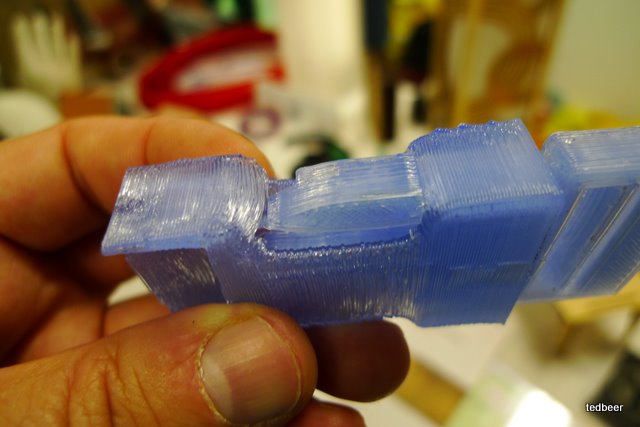
')
Eric was the first to speak, mainly talking about his path, the creation of an ultimaker and the company, the history of the development of the RepRap community, which makes the technology accessible to the masses. I told about the ultmaker above.
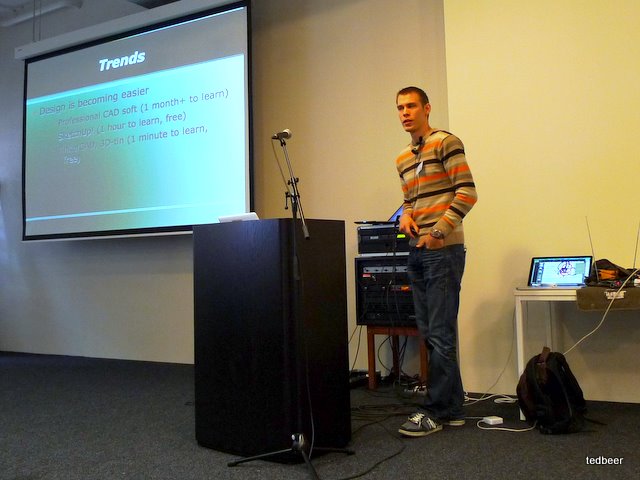
Among other slides in the speech of Eric I was struck by a slide with a tree of the descendants of reprap. The original can be viewed on the company's website .
Next came Bas van Abel , who spoke more about the social aspect of technology development in general, and not just 3D printing. I liked his story about materials for the manufacture of cell phone batteries. We have no idea how this is done, so we do not feel any responsibility for the use of technology. Watch the video on the organization's website. It briefly describes the mining of cobalt in the Congo. Workers at a depth of 60 meters spend several days mining ore, a cat. then washed outside in monstrous conditions. Child labor is widely used. Then the ore is exported to the manufacturer for enrichment and further processing to get into the cell phone battery. And then Apple will make the battery non-removable, in order to discard the phone in a year or two as soon as the battery degrades. And after that, this high-tech garbage goes to India, where sacred cows and children graze in the rubbish rubbish, again, are engaged in extracting valuable components for recycling, and other waste remains in the rubble. In general, they distracted a little from 3D printers.
Then suddenly Joris Peels appeared on the scene. And I painfully recalled where I intersected tightly with him. And it seemed to me that I had already seen part of this presentation as if in a dream. Well, I could not remember him so well from my night vigils. Maybe somewhere else saw? And only during the break, when he greeted me vigorously and called by name I remembered that I worked with him in Backbase. Of course! True, I am in RnD, and he is somewhere in marketing and sales. And now it turned out that he founded the company and is developing a 3D printer for children ! Briefly highlighted the main printing technology. He complained about the lack of simple and intuitive tools for editing 3 models that would be accessible to children.
One slide from Joris presentation:

Although initially it was not intended for publication without a speaker, there is little to be understood, but in some places there are funny slides like the one above and the current technologies are briefly listed. So if you are interested, then look through - Joris presentation .
I asked him when he plans to release his brainchild to the market. In general, not soon, after a year and a half. Let's hope for the best.
Then there was lunch and you could walk around the exhibition, touch it, talk to the representatives. Ultimate makers intensively printed a variety of garbage with thingiverse.com (a famous site where people share their 3D models).

Mobile device in the Dutch style - on the bike. Unfortunately, I did not ask what was there inside. There was also a person who transferred his printer to batteries.
But a giant two-meter unit capable of printing a chair. But it seems with printing accuracy there is generally bad. Many parts are made of material type dvp (or whatever it is called thick cardboard).
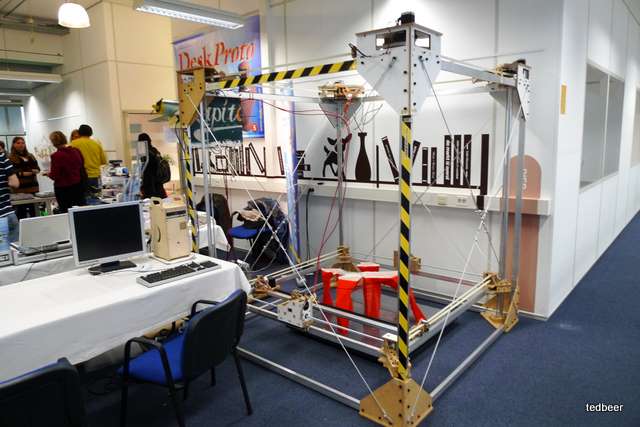
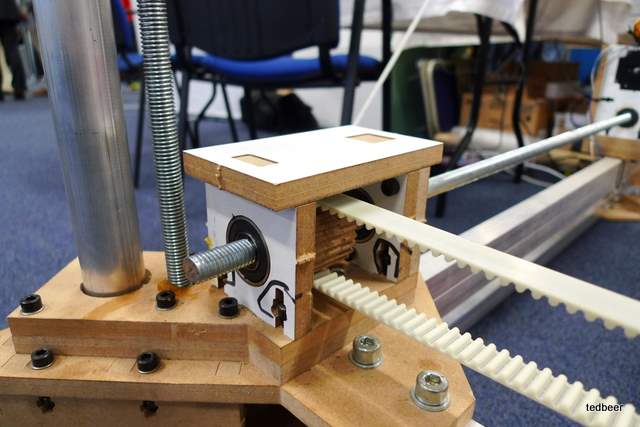
Although the ultimate maker is also not made of cosmic materials, but laser-cut from birch plywood:
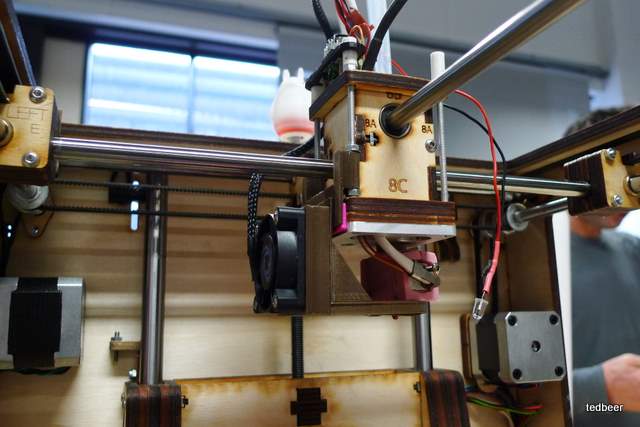
Session 2 seemed to me not very interesting. But in the 3rd were the professionals of 3D printing.
Antonius Köster is the director of a German company that has been engaged in a variety of scanning and 3D printing in many fields for several years. He described numerous areas where 3D printing is in demand, his projects on which the company worked. On the slide there is a figurine costing one and a half million non-rubles. To transport the exposition, the figure was scanned and an individual form was made for it:
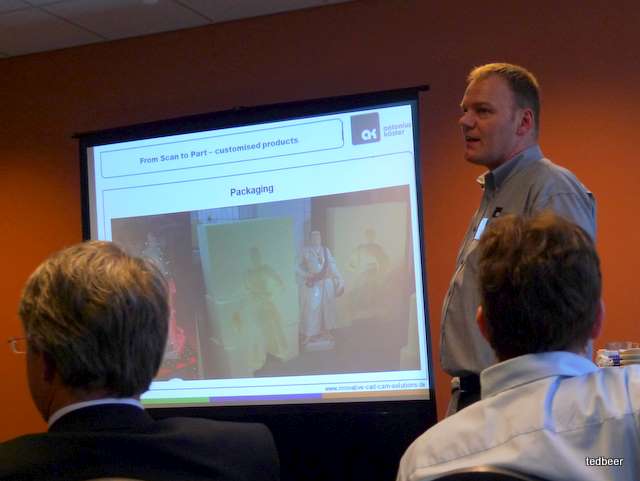
For example, in surgery, an X-ray 3D image is taken that prints a model of the skull. This model examines where the nerve canals pass and the operation is planned. When overlaying metal brackets to seal the broken parts of the skull, these brackets bend in place on the model of the skull. Prior to mastering 3D scanning and printing, the brace was bent in place during surgery by the surgeon. This means that the operation lasts a lot longer, and the cost of the surgical operating room is 300 euro per minute. Printing 3D models and materials are cheaper. So on the face (on the face :)) cost savings of the patient.
Rene Groothedde , director of RMCenter, talked a little about European programs for exploring the possibilities of using 3D printing in various industries such as aviation, automotive, etc. For example, there was the idea of 24-hour availability of spare parts for repairs to, say, an aircraft. For this item just need to print on the spot. There are problems with certification. Due to the difference in materials and manufacturing techniques of parts, it is necessary to change the design of the part. In addition, performance changes, so parts must be certified in different ways. In the aviation industry, parts are replaced according to the regulations. Those. a part has a service life, and it is changed when the time expired, and not when it broke. The printed part will have a different time limit. In general, there are enough difficulties on this path. It seems the print experiment was a big part of these European programs. In the course also highlighted the problems with licensing. Take, say, a washing machine. The right to manufacture parts for it may be required to license; These parts can be patented. Those. you can’t just pick up and print a replacement part for a broken customer or even yourself. In general, big business, as always, is the city of fences and obstacles, where it would seem that they do not smell.
Darrin Dickinson - representative of the company producing Z printers , spoke about the company, technology and the growing demand. Their printers print with powder and binder. The binder is colored in 3 or 4 colors (CMYK) as in inkjet printers, so you can print multi-color models. If we add to this that the printing accuracy reaches 600dpi, then it is not surprising that the printed models look really superb. Obuvku even want to feel until you pick up. Such a heavy boot can be accidentally nailed: lol: Well, the printed models are not very functional, because quite fragile.
During the conversation, after his speech, I asked about similar works of competitors or amateurs. But he assured me that all sorts of powder printing options and related technologies are patented wherever possible, so that not a single scum will break through. Such a statement certainly does not add optimism in the development of technology in this direction. We can say that this is another evil corporation, which rows for itself.
The presentations ended and the informal part began with beer, wine and other drinks and snacks. I spoke with a representative of the company selling professional Dimension printers working on the same principle as the amateur one. But unlike them, he can print with two plastics at once. One is used to print supporting structures, without which, in many cases, it is necessary.
The device from the Dimension series looks solid:
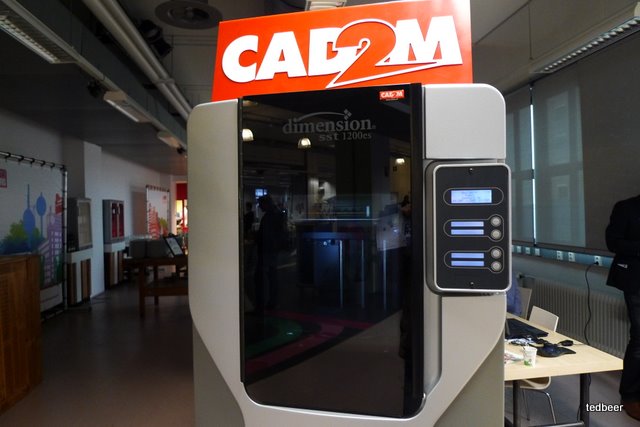
Items printed by this printer. Among them is a yellow case printed for some device. Both halves so exactly fit into each other, that you don’t have to be screwed together!
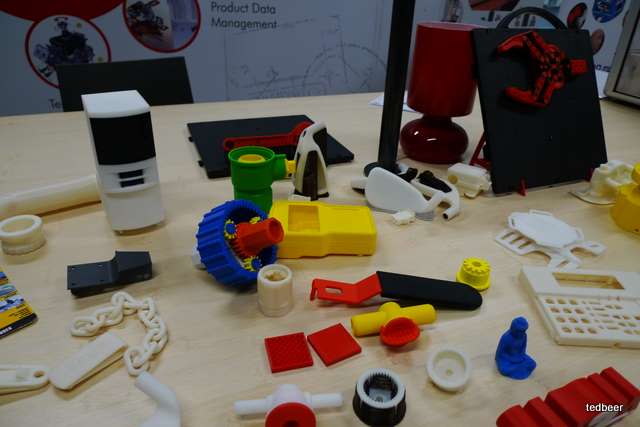
The adjustable wrench is printed in one pass does not demand assembly:
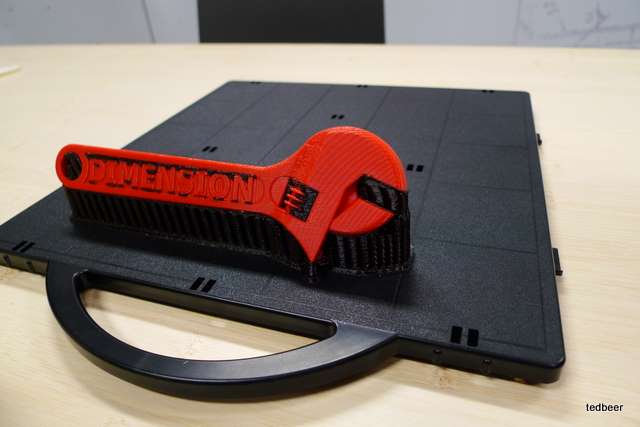
Black plastic is an additional material that is then dissolved with a special solvent and washed out. As a result, in the key all that is necessary is spinning and moving.
Another amateur machine. Note that he has both a print head and a milling cutter (yellow-green crap sticks out on the left). Those. It can work both as a printer and as a CNC. The owner said about the device is not very good. He says that he "redesigned" (overconstructed). It turned out too slow due to the use of screw positioning on all axes, although accurate. Plus, the milling cutter is rather weak, positioning engines, too, so this margin is not required, and the speed had to be sacrificed.
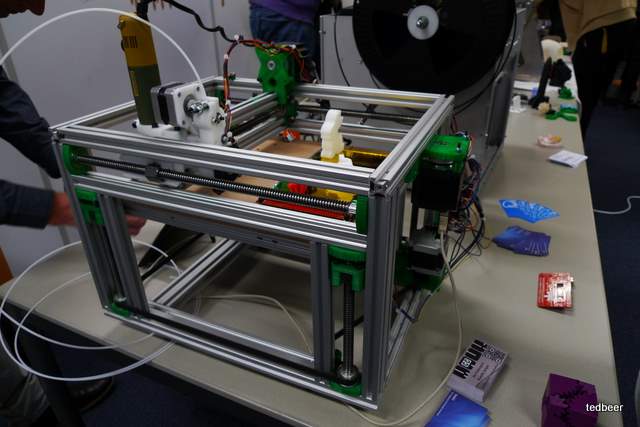
The new model of the ultimaker is one and a half times higher than the original one and allows you to print high models like the yellow one in the photo. The model is not yet launched in the series.

New technologies can serve not only good:

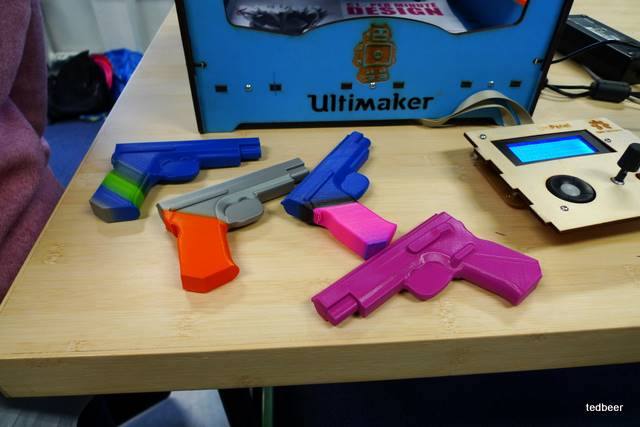
Perhaps it is time to stop. The topic is inexhaustible. Next year promised to continue. So I will keep my finger on the pulse.
Source: https://habr.com/ru/post/131460/
All Articles